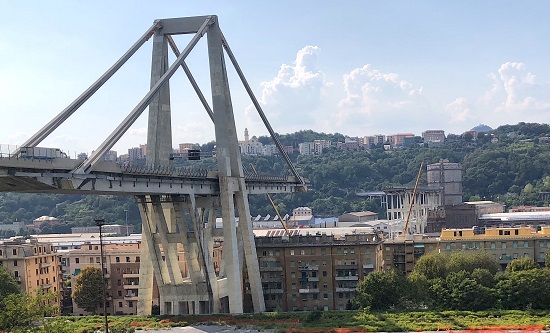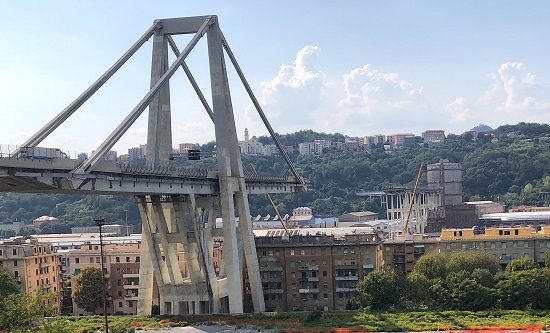
On 14 August, a 200-metre section of the Morandi bridge in Genoa, north-west Italy, collapsed, killing 43 people. About 30 vehicles plummeted 100 metres as the carriageway beneath them gave way, mostly onto rail tracks. Eye witnesses said that the central pillar of the bridge crumbled before the rest came down with it. Afterwards, photos taken only a few weeks before showed the bridge’s dilapidated state, with broken cables hanging disconcertingly from the sides. The disaster has triggered a fresh debate about why Italy’s ageing infrastructure has been allowed to fall into disrepair. While fingers have rightly been pointed at the EU and years of austerity, these factors have to be put in the context of an ever-deepening capitalist crisis. Brian Henry reports.
The Italian transport minister, Danilo Toninelli, immediately blamed the collapse on poor infrastructure maintenance and pledged that those responsible ‘would pay’. The government – a recently-elected coalition led by the Five Star Movement[1] (5MS) – has threatened to revoke concessions held by Autostrade per l’Italia – a unit of the infrastructure group Atlantia which managed the bridge – covering nearly half of Italy’s motorways. Shares in the company plunged after Luigi Di Maio, 5MS party leader, suggested he would impose huge fines and that renationalisation was the ‘only solution’.
Giancarlo Giorgetti, the undersecretary in the prime minister’s office, said the government would launch a ‘maintenance operation with no precedents, with enormous investment in public works’. He could not specify the cost of the plan, but claimed deficit, GDP or EU rules would not apply, and insisted that the EU ‘will be benevolent’.
The European commission limits the budget deficit of EU member states to 3% of GDP – in 2017 Italy’s stood at 2.3%. And while the Maastricht Treaty requires governments to limit national debt to 60%, Italy’s already stands at 132%. The populist coalition came to power promising to ease austerity with €100bn of public spending. Investors are concerned that its spending plans will ignore EU fiscal rules and push up the country’s debt still further, the highest in the eurozone after Greece.
Matteo Salvini, the far-right interior minister from the Lega, the second party in the populist coalition, blamed the EU’s budgetary constraints for impeding maintenance. The EU said member states are free to set specific policy priorities, adding that it had approved €2.5bn for Italian infrastructure, including roads, in the 2014-2020 budget, and that it approved in April another €8.5bn investment plan for Italian motorways, including those in the Genoa area. But figures from the Organisation for Economic Cooperation and Development (OECD) show that Italian investments in roads has fallen the most among the top five European economies after the 2008 economic crisis. From a level of just under €13.6bn a year in 2007, second only to France, Italy dropped to just €3.39bn in 2010. It rebounded slightly to €5.15bn in 2015, still just half the levels of Germany, France or Britain. Beyond roads specifically, over the last decade Italy’s direct public investment has been slashed by almost 40%.
Privatisation and corruption
Autostrade has pledged €500m (£449m) to rebuild the bridge and has set up funds to assist the families of the victims. Restructuring work on the 51-year-old bridge was carried out in 2016. The highway operator said work to strengthen the road foundations of the bridge was being carried out at the time of the collapse, and claimed the bridge was constantly monitored. When it was inaugurated, it was vaunted as a leading engineering achievement that would last 100 years.
Autostrade is already being prosecuted over the death of 40 people who died when a coach crashed through a guard rail on a motorway viaduct in 2015. It is alleged that the bolts anchoring the guard rail were corroded.
Some cabinet ministers have attacked a cozy relationship between the Benetton family that controls Autostrade and previous governments that prevented proper oversight. The construction industry in Italy is also deeply infiltrated by mafias. The state’s corruption has fed Italians’ distrust of public spending, helping to limit calls for nationalisations.
Many technicians had advised replacing the Genoa bridge. The tragedy has sparked calls to retrofit or replace other bridges in Italy that are operating well beyond their expected lifespan. Italy has had 12 other bridges and overpasses collapse since 2004, killing seven people overall. In 2015 a €13m viaduct in Palermo collapsed within days of opening. Recent collapses have occurred in northern, central and southern Italy, defying stereotypes of a well-maintained, wealthy north versus a neglected south.
A civil engineer told la Repubblica that three hundred other bridges and tunnels around Italy are in an extreme state of disrepair. That he wished to remain anonymous tells its own story about fears of offending the thugs who own Italy’s thoroughfares.
Since 1999, when Italy’s road infrastructure was sold off by Massimo d’Alema’s ‘centre left’ government, the motorway network has been under the control of private interests. The deal, similar to the ‘public-private partnerships’ beloved by New Labour, resulted in Italy having among the most expensive road tolls in Europe, managed by cost-cutting firms who pay low taxes in Luxembourg.
Five-star hypocrisy
5MS’s commitment to taking on the corruption at the heart of ‘crony capitalism’ was a key plank in its rise to national government. In the wake of an expenses scandal that ruined the Democratic Party candidate, M5S’s candidate, Virginia Raggi, swept to victory in Rome’s 2016 mayoral election. But Raggi herself soon faced police accusations of kickbacks, and the 5MS quickly abandoned its own internal anti-corruption charter. The investigation was later dropped, but Romans remain unimpressed by Raggi’s efforts to resolve the city’s transport problems.
5MS’s ability to blame previous governments for the Morandi collapse has been blunted by the circulation of a 2013 statement on its website in which it backed a campaign against building a second motorway, the ‘Gronda’, over Genoa, which would have reduced traffic on the Morandi. In this since-deleted statement the possibility that the Morandi could be considered ‘close to collapse’ was dismissed as a ‘fairy story’.
Coalition partner the Lega won barely half as many votes as 5MS in March’s election, but today the coalition partners are level in the polls. The Lega wants a 15% flat tax rate that would deprive the state budget of close to €100bn a year. Clearly that would make a public works programme even harder to pay for.
In Italy it is a common lament that everything has gone downhill since the Romans and the Renaissance. Breathtaking Roman bridges are still in use but an aesthetically dull 20th-century construction lasted barely 50 years. 21st century capitalism, with its unending crisis necessitating years of austerity, isn’t made of the same stuff.
[1] See ‘Italy: Renzi resigns after rise of ‘anti-establishment’ Five Star Movement’, www.revolutionarycommunist.org, 27 March 2018 http://www.revolutionarycommunist.org/europe/italy/5154-italy-renzi-resigns-after-rise-of-anti-establishment-five-star-movement




